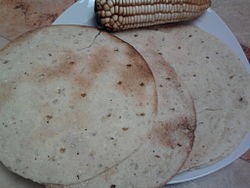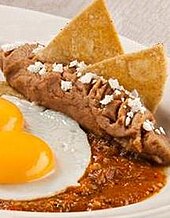Totopo
 | |
| Place of origin | Mexico |
|---|---|
| Region or state | Oaxaca |
| Created by | Zapotec peoples |
| Main ingredients | corn Masa, salt |

Totopo, in Mexican cuisine, is a flat, round, or triangular corn product similar to a tortilla, that has been toasted, fried or baked, but it may be prepared with nixtamalized corn masa. Totopos are best known as originating from Zapotec peoples of the isthmus of Tehuantepec region of the Mexican state of Oaxaca. There, the Zapotec women bake totopos in a clay oven known as a comixcal. Totopos resemble a round, baked tortilla chip or certain types of Scandinavian flat bread, however, unlike tortillas, salt is added to the masa and holes are made in the disk prior to baking.[1]
Totopo may also refer to triangular fried tortillas (totopos de maiz). When the whole round tortilla is baked or fried it is generally known as a tostada.
An important feature of the baking and salting process is preservation. To prevent the decomposition of the corn and growth of mold, regular tortillas generally need to be eaten the same day as they are made (or stored cold) due to the moisture content, whereas totopos may be stored for future consumption, in the same manner as dry crackers.
In some cases, fried tortilla chips commercially made both in Mexico and the United States are labeled as or referred to as totopos, although they are not made in the manner of the Oaxacan totopo.
Etymology
The name, totopo, comes from the Aztec (or Nahuatl) tlaxcaltotopochtl. This name is a compound of the word for a tortilla, tlaxcalli, plus the word for thunder. The combination means approximately tortillas that are noisy to chew.[2]
References
- ^ Nancy Zalavsky (1997). A Cook's Tour of Mexico: Authentic Recipes from the Country's Best Open-Air Markets, City Fondas and Home Kitchens. Macmillan. pp. 12–13. ISBN 9780312166083. Retrieved 8 January 2013.
- ^ "Tortilla Has Many Origins". Indiana Post-Tribune/Sun-Times Media, LLC via HighBeam Research. May 1999. Retrieved 3 May 2012.(subscription required)
External links
- Photos of totopos and explanation in Spanish (link broken as of 2009-05-09, archive copy)
- [1] Photos of
- Totopo Oven Comixcal













